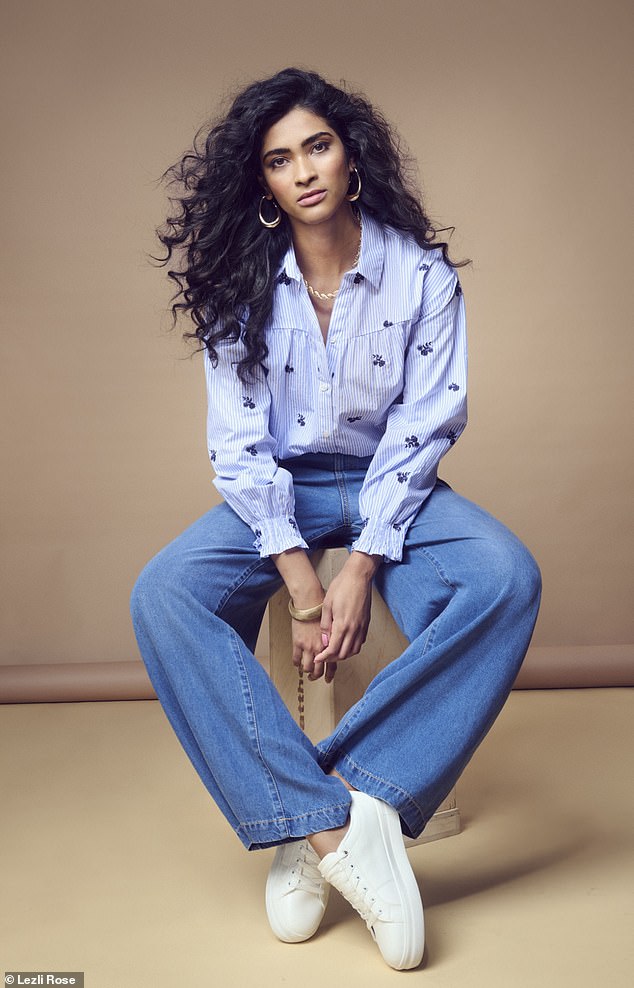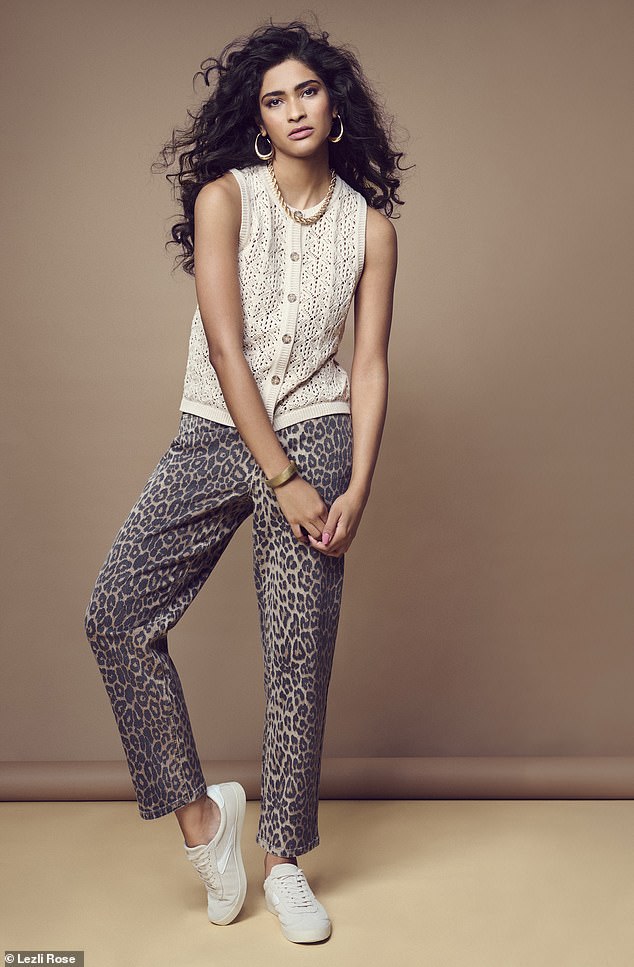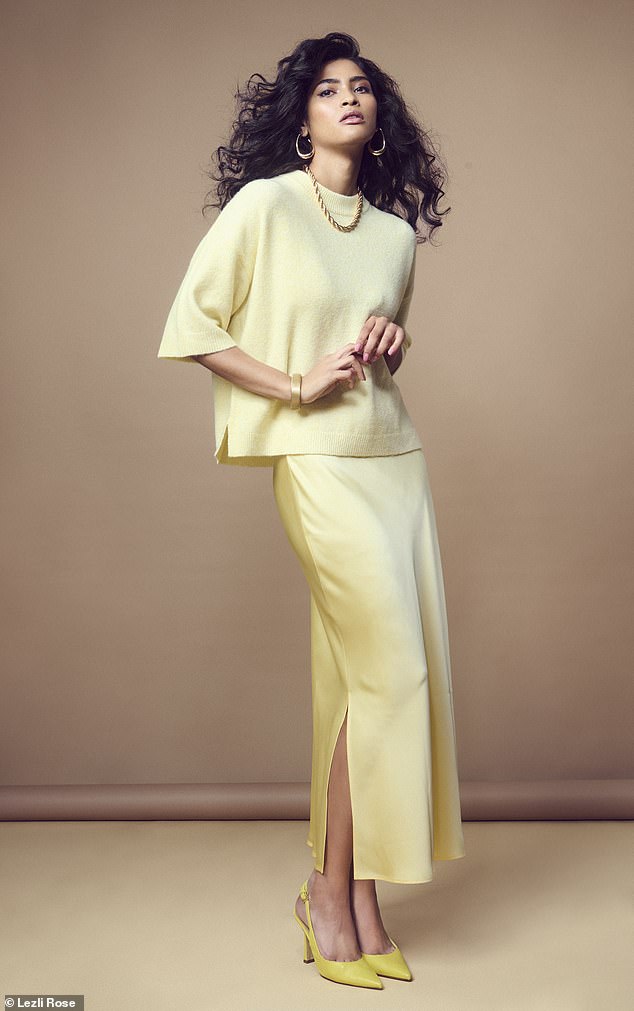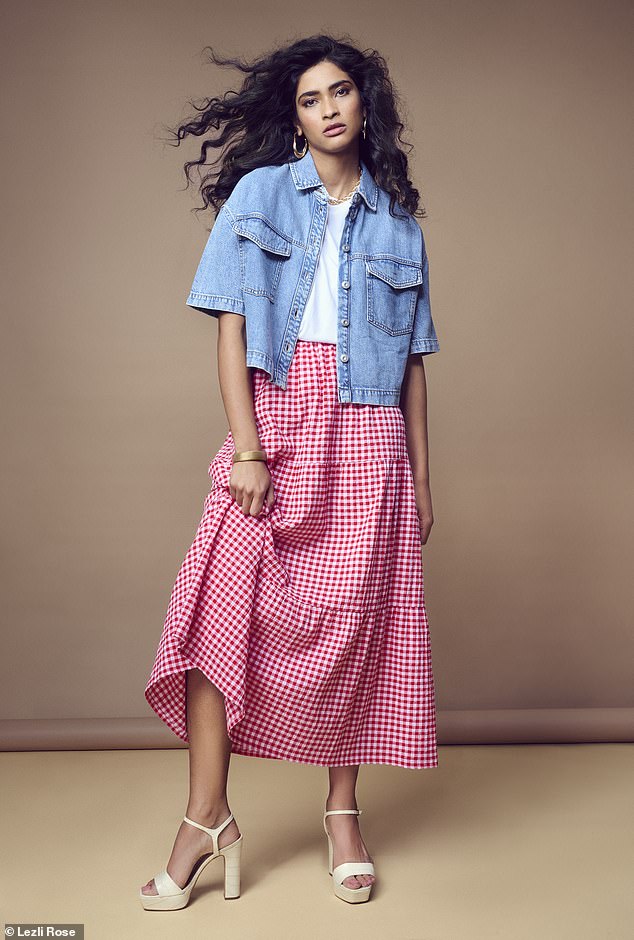Hands up, I have never bought a piece of clothing from a supermarket. And yet, earlier this week, I found myself wearing a smart, red, boucle, cardigan-style jacket from George at Asda for a dinner with the Queen.
Clearly, those are words I never expected to write. Until very recently I hadn’t even considered looking at clothes from the places where I buy my Persil and porridge oats.
Usually at an evening in the presence of royalty, I would wear something by one of my favourite high-end designers – Erdem or perhaps Bella Freud or Dolce & Gabbana – but, as it happened, that night I had been sent some supermarket clothes to road-test.
The event was a celebration of The London Library, where the Queen is now royal patron and the actress Helena Bonham Carter, resplendent in vintage that evening, is president. I had been considering wearing a favourite green silk Saloni dress – but seeing the jacket I thought, ‘Why not give it a go?’, and paired it with a patterned Rixo midi dress (see Alexandra, pictured above).
And do you know what? It absolutely held its own among the designer pieces from Emilia Wickstead, Armani and The Row, (As in, nobody said: ‘What’s that bit of tat you’re wearing?’ Not, it has to be said, that a gathering of philanthropical literati is necessarily the most highly fashion-conscious crowd).
The fact is, supermarket clothing is on the up.
My conversion began late last year, when I saw my colourist Melanie, who was wearing a very chic black dress that turned out to be from Tu at Sainsbury’s. That dress, I now discover, was one of the store’s big Christmas hits and in part responsible for sales of occasion-wear growing by 125 per cent year-on-year. This week, Melanie had a great black velvet trouser suit from the same place. Clearly, it was time for a re-think.
Back in the dark ages – 1996 – I put together an issue of Vogue that was entirely dedicated to the high street. A very young Kate Moss appeared on the cover with her hair artfully styled by Sam McKnight – so far, so normal. But her clothes were unexpected: a £22.50 pink cotton top from Debenhams and white, low-slung trousers for £50 from the long-departed Morgan.

Actually, considering how long ago it was, and how much cheap fashion there is now, those prices don’t seem so inexpensive, but they were the very first clothes from the high street on a Vogue cover.
Indeed, every item in that issue came from those stores, including Kate’s top ten buys, which featured a Ravel snakeskin wedge shoe for £60, a lace Topshop shirt at £17, and Hennes check hipsters for £38.
The resulting outcry from the Bond Street fraternity representing the top design houses was loud and impassioned. What on earth was Vogue doing featuring the high street on its precious pages? We were meant to be the town-crier for luxury, not mass-produced junk. Crazy as it now seems, high street fashion carried a stigma. If it was cheap, how could it be good?
Back then, Vogue spoke of buying ‘cleverly’ not ‘cheaply’ –the word ‘cheap’ clearly having unchic connotations. So welcome to clever shopping circa 2025.
Although the high street no longer carries that down-market resonance – no one would turn their nose up at staples such as Jigsaw or Whistles nowadays – supermarket fashion today still has to battle with prejudice and snobbery.
Having had an exclusive preview of their Spring/Summer collections, however, it’s obvious they are making exceptional headway to win the doubters over. That red jacket I wore to meet Queen Camilla is a deep cherry with none of the cheaper pastel tinge or harsh orange that can lurk in inexpensive red fabrics. The trim has remained attractively frayed rather than falling-apart frayed.
Yesterday, I took another George piece for a trial run – a striped cotton shirt with small blue flowers embroidered on it and delicately frilled elasticated cuffs. It was delicious.
I wore it to a talk at Marfa Stance, a very trendy label that makes high-end outerwear worn by the inhabitants of Hollywood and London’s Notting Hill. If anything, I think I looked rather smarter than the other women there that day! The cotton stayed crisp and the boxy shape worked both tucked into a skirt, and later, worn loose and under a knitted vest as the day got colder. I definitely want to buy it – and at £18, I certainly will.
As with all collections you need to fillet carefully and a couple of outings hasn’t given me enough experience of how well they wear, but what I have worn stood up just as well as any mid-market piece of clothing.
All the representatives of these supermarket clothing lines are keen to highlight their companies’ sustainability and ethical production credentials, too – unsurprising, given the dodgy reputation fast fashion has in these areas.
Their incredibly low prices could raise eyebrows, but apparently this can be explained by the numbers involved. When you sell 40,000 units of a party dress in days –as Tesco’s F&F range did last Christmas – you can keep costs low.
I don’t think I’ll be shopping for all my clothes at the supermarket, but I have realised that the main obstacle to their success among people like me is ignorance.
We don’t know what’s on offer, especially as many of us don’t actually go into the stores to shop, which is where they have the best display, but instead get our weekly shop delivered.
At the moment, telling friends you’re wearing something from Morrisons or Sainsbury’s is more likely to provoke amused curiosity than a desperate: ‘I want it, too!’ But it shouldn’t.
It’s the fashion-forward pieces that are selling best, though the supermarkets all have reliable basics and a very respectable looking man I spoke to at The London Library told me he swears by George at Asda boxers.
My main criticism is that these brands don’t have a distinctive style. We go to a supermarket to buy a range of different products housed inside their huge brand.
But fashion isn’t like that. If supermarkets want to be regarded as a fashion destination in their own right, they need to carve out more of an individual identity. It’s not clear enough what Tu, or Nutmeg, or George, or F&F each stand for. When they manage that, I reckon they will have got this potentially enormous market cracked.
Asda

George at Asda was a pioneer, launching in 1989 with fashion entrepreneur George Davies, the founder of Next, at the helm.
This summer, it’s invested in leopard print (known by some in fashion as a ‘neutral’ as it goes with everything). Its leopard- print puffa (£38) sold out within two hours online.
You could easily mix this lovely striped shirt (£18), with its nod to French label Sezane, with its leopard-print trousers for a noisy, Instagram influencer look.
Morrisons

Nutmeg has made huge strides since launching as a mother-and-baby brand in 2013, adding womenswear in 2017 and menswear in 2020.
Louis Vuitton and Ralph Lauren were on recent mood boards, I’m told.
Everything in the latest collection is machine-washable and designed with a busy mum in mind as a core customer.
The padded black quilted waistcoat with white stitching (£22) is a standout buy and will delight anyone who loves Isabel Marant but can’t even dream of affording her prices.
Tesco

Tesco’s F&F has come a long way since it launched as the unfathomably bad Florence & Fred in 2001.
Its linen and viscose trench (£49.50) is perfect for summer, and the feel of it indicates it will last.
For spring, F&F is majoring on boho – personally, I think boho is a risky look for the slightly older customer.
However, its woodblock olive and white print dress (£25) is lovely, and teaming it with the recycled polyester bomber (£35) cuts the potential tweeness.
Sainsbury’s

Driven by more fashion-forward shapes, such as barrel-leg, sales of Tu jeans are up 159 per cent on this time last year. Its denim also comes in an appealing dark navy.
The culottes are worth a look – team with the standout prairie-style sky-blue shirt with ruffled front (£24).
Good shoes are very difficult to produce inexpensively, but Tu has bucked the trend and this summer has some great closed‑toe fisherman sandals (£20) as well as white kitten-heel slingbacks (£20) that could give Miu Miu a run for its money.

